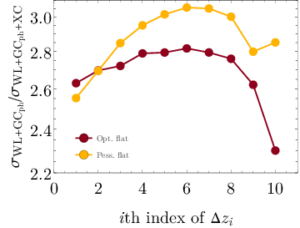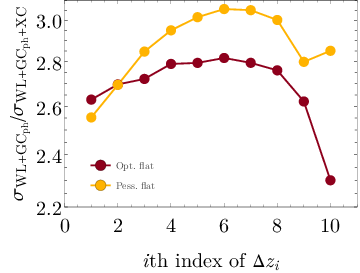Abstract
Context. The data from the Euclid mission will enable the measurement of the angular positions and weak lensing shapes of over a billion galaxies, with their photometric redshifts obtained together with ground-based observations. This large dataset, with well-controlled systematic effects, will allow for cosmological analyses using the angular clustering of galaxies (GCph) and cosmic shear (WL). For Euclid, these two cosmological probes will not be independent because they will probe the same volume of the Universe. The cross-correlation (XC) between these probes can tighten constraints and is therefore important to quantify their impact for Euclid.
Aims: In this study, we therefore extend the recently published Euclid forecasts by carefully quantifying the impact of XC not only on the final parameter constraints for different cosmological models, but also on the nuisance parameters. In particular, we aim to decipher the amount of additional information that XC can provide for parameters encoding systematic effects, such as galaxy bias, intrinsic alignments (IAs), and knowledge of the redshift distributions.
Methods: We follow the Fisher matrix formalism and make use of previously validated codes. We also investigate a different galaxy bias model, which was obtained from the Flagship simulation, and additional photometric-redshift uncertainties; we also elucidate the impact of including the XC terms on constraining these latter.
Results: Starting with a baseline model, we show that the XC terms reduce the uncertainties on galaxy bias by ∼17% and the uncertainties on IA by a factor of about four. The XC terms also help in constraining the γ parameter for minimal modified gravity models. Concerning galaxy bias, we observe that the role of the XC terms on the final parameter constraints is qualitatively the same irrespective of the specific galaxy-bias model used. For IA, we show that the XC terms can help in distinguishing between different models, and that if IA terms are neglected then this can lead to significant biases on the cosmological parameters. Finally, we show that the XC terms can lead to a better determination of the mean of the photometric galaxy distributions.
Conclusions: We find that the XC between GCph and WL within the Euclid survey is necessary to extract the full information content from the data in future analyses. These terms help in better constraining the cosmological model, and also lead to a better understanding of the systematic effects that contaminate these probes. Furthermore, we find that XC significantly helps in constraining the mean of the photometric-redshift distributions, but, at the same time, it requires more precise knowledge of this mean with respect to single probes in order not to degrade the final "figure of merit".


